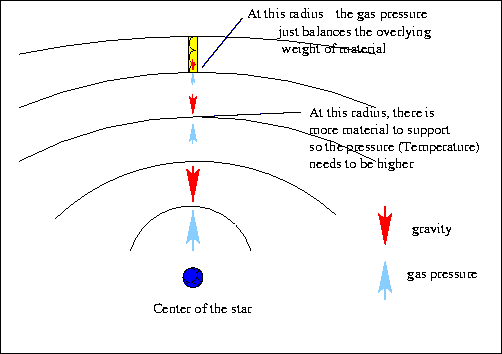It's all based on the concept of
HYDROSTATIC EQUILIBRIUM
- the downward force due to gravity (i.e the weight) of the gas must be
balanced by the upward thermal pressure of the gas.
If these forces were not equal, the star would be collapsing inward
or expanding outward.

The pressure exerted by a gas increases as the temperature of the
gas increases. If you think about a container filled with gas atoms
or molecules, the thermal pressure exerted on the walls of the
container is due to all the atoms and molecules bouncing off the
walls. Remember, temperature is a measure of the mean kinetic energy of
the gas particles.

At each level moving down towards the center of the Sun, the
total column of mass above every point increases, so the Gravitational
Pressure increases as you move in from the surface of the Sun. To
maintain Hydrostatic Equilibrium, the Thermal Pressure must also
increase with depth which requires that the temperature increase
toward the center of the Sun.
With computers it is possible to build (we think) very
accurate models of the Sun and other stars based on the
the requirement of hydrostatic equilibrium and the laws
of chemistry and physics. We can predict the temperature
and density of the Sun at each radius from the center to the surface.

You can see that the temperature at the center of the sun
(T = 1.5 x 107 K) is much greater than the temperature at the
surface of the sun (T = 5800K). The central temperature of the sun
is definitely high enough for nuclear fusion to take place there.
Actually the temperature is high enough that fusion can take place
in the inner 10% of the sun.
- The Universe is changing in one direction - H
 He .
He .
- The Sun, and other stars too, will eventually run out
of fuel.
We calculated the lifetime of the Sun as an H-fusion-powered object, but
this assumed the entire Sun was pure Hydrogen and that ALL the hydrogen
could be fused to Helium. In fact, by the time that about 10% of the Hydrogen
is fused to Helium the Sun will change its structure and will no longer
be a main-sequence star.
- We can already figure out the rough main-sequence lifetimes
of stars of different masses.
A 10 M has a central temperature of
30,000,000 K and a luminosity of 40,000
L
has a central temperature of
30,000,000 K and a luminosity of 40,000
L .
.
We know that the fuel of stars is mass and that the
rate of fuel consumption is the luminosity. So the
10 M star would be expected to live 10 times
longer based on its extra fuel, but, 1/40000 less long based on its fuel
consumption:
star would be expected to live 10 times
longer based on its extra fuel, but, 1/40000 less long based on its fuel
consumption:
Lifespan ( 10 M ) ) |
= |
10
|
x |
Lifespan ( 1 M ) ) |
= |
0.00025 x Lifespan ( 1 M ) ) |
| 40,000 |
Similarly a 0.3 M star with
0.01 L
star with
0.01 L would have a main-sequence
lifetime that was:
would have a main-sequence
lifetime that was:
Lifespan ( 0.3 M ) ) |
= |
0.3
|
x |
Lifespan ( 1 M ) ) |
= |
30 x Lifespan ( 1 M ) ) |
| 1/100 |
So even though more massive stars have more fuel (mass),
they use it up faster (higher luminosity) and so have shorter main sequence
lifetimes than the less massive stars.


 Michael Bolte
Michael Bolte
Fri Feb 6 23:24:56 PST 1998

 107 K
107 K







 He .
He .
 has a central temperature of
30,000,000 K and a luminosity of 40,000
L
has a central temperature of
30,000,000 K and a luminosity of 40,000
L